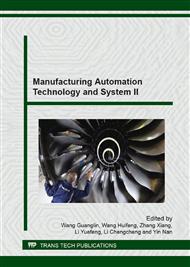p.413
p.419
p.425
p.431
p.437
p.443
p.450
p.456
p.462
Static Performance Analysis of Foil Thrust Bearing Based on Thin Plate Theory
Abstract:
The thrust foil bearing, as one of the key parts in high-speed rotating machineries, is used to sustain the axial force, and its load performance has a crucial relationship with the structural parameters and working condition. In this paper the top foil is modeled as a thin plate supported by the bumps underneath. The finite element method (FEM) is used to calculate the structural deformation coupled with the pressure distribution obtained through the solution of Reynolds equation by the finite difference method (FDM). The effects of structural and operating parameters, such as rotational speed, eccentricity ratio, top foil thickness and bump foil thickness on the load capacity and frictional torque are discussed in detail. The results show that the increase of rotational speed, eccentricity ratio and bump foil thickness is beneficial to increase the load capacity and frictional torque. The effect of variation of top foil thickness on load capacity is not obvious, which implies that the top foil plays a role in building the lubricant surface rather than providing supporting stiffness.
Info:
Periodical:
Pages:
437-442
Citation:
Online since:
August 2014
Authors:
Price:
Сopyright:
© 2014 Trans Tech Publications Ltd. All Rights Reserved
Share:
Citation:


